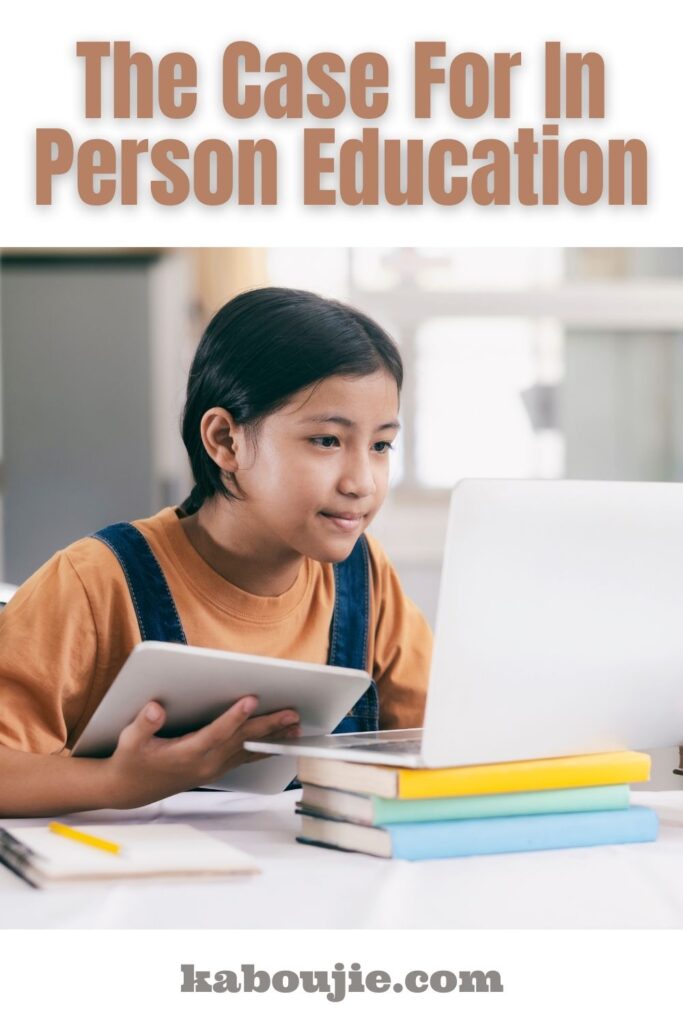Many parents, concerned about the quality of education being impacted by on-again, off-again schooling, have started looking at online options for their children. The challenges are indeed enormous but perhaps what is missing from the online versus on-campus schooling debate is the case for in person education.
School is one of the critical environments where learners can develop a sense of belonging[1]. A great deal of research around the desire to connect has shown that support from and spending time with friends can help reduce depression and anxiety[2],[3].

Identity construction is grounded in the actual process of socialisation. This process is founded upon the ties that a child or adolescent manages to forge with peers, teachers and non-family adults as well as centres of activity in his or her environment. [4]
Communication and collaborative problem-solving; cultural awareness and expression; understanding local and intercultural issues; taking initiative in order to influence others (leadership) and resilience – all require empathy and tolerance, which is best developed in person. [5] [6]
The supportive roles played by teachers and non-family adults are optimally facilitated by being with and listening to learners during their day-to-day activities. Without a pre-existing in-person foundation, engagement and accountability are far more difficult.
Movement, sunlight, autonomy and connection are critical during the school day for maintaining wellness. This allows for the release of dopamine, norepinephrine and serotonin that every teen needs to feel good, focus and maintain engagement with their studies.
On-campus schooling also means that children are protected from too much screen time, which is linked to stress in the visual system and visual impairments (which can become permanent).
How Are The Kids Coping?
Online learning removes the need for movement between classes, the choice of activities in a school environment, time outdoors and exposure to sunlight, social interaction and check-ins with peers that give teenagers the hit of dopamine they need to maintain wellness. [7]
Seeing oneself on the screen often throughout the day, or continuously, leads to stress, especially in teenagers, many of whom are preoccupied with self-image[8].
Rates of depression and anxiety amongst learners have surged as a result of their being denied daily contact with their peers[9],[10]. While all children need peer interaction for healthy development, adolescents are perhaps most acutely in need of this.
Unfortunately video calls (Zoom, Google Meet, MS Teams, etc) are a poor substitute for in-person interactions because the crucial non-verbal cues (tone and pitch of voice, facial expressions, eye contact, and body language) that we rely on for connection and accurate comprehension are compromised. This means that our brains must work harder to process information, which can lead to fatigue and states of stress that detract from cognition and wellbeing 7, 8.
It is also difficult for a student to filter background noise and focus on the teacher’s voice when all student contributions are as loud as each other. This leads to overstimulation and feelings of frustration or fatigue[11].
Optimal time for a Zoom meeting or class is 20-30 minutes, but class length routinely exceeds this in online school offerings[12]. For every 20 minutes spent on a device, a child needs a short break, to adjust their gaze and to blink in order to lubricate their eyes to combat eye damage and burnout. Online learning programmes often do not incorporate a helpful response to this need and it is mostly not possible for a parent to monitor and address.[13] [14]
The impact of online schooling on family dynamics varies but, in some families, has proved destructive and unsettling. 21 Many ECD and Junior Primary households struggled because of the increased demand on parents to facilitate schooling at this age.
Finally, academic outcomes are also negatively impacted by online schooling, although the negative impact can be reduced by incorporating peer interaction or small group activities into synchronous online courses[15].

Advice For Parents Considering The Two Options For Their Children
Carefully consider your child’s psychosocial and physical development needs in the context of the available research and relative to the offerings you are considering. The small group of students whose needs are better met through online schooling, will benefit as long as they have access to the necessary infrastructure.
Some online offerings are promising to augment themselves with in-person experiences (sports, clubs and the like) – consider that they are conceding the critical importance of in-person interaction and make sure that you are comfortable that they can deliver to the standard that more traditional schooling can.
Predominantly or exclusively online schools will have their work cut out to make up for the loss of in-person interaction, sports, clubs, break times and social events, if they even see this as their responsibility.
Conclusion
Not all public and private schools are well resourced, and the pandemic has hugely exacerbated educational inequality in South Africa[16], so innovative online offerings that present hope of improved educational outcomes for students in dysfunctional schools, or in schools struggling with curriculum recovery are to be welcomed.
It may be that in the short term, curriculum recovery at schools in crisis could be supported by a sustainable online offering, however, this presupposes the presence of the hardware, software, data and training required to facilitate access, and should not happen at the expense of teacher recruitment, training and development.
The pandemic experience has confirmed, for most, the benefits of in-person schooling. Online resources and platforms should be used for augmentation purposes, not as replacements for in-person schooling.
With fewer than 3-million of the more than 13-million learners in basic education operating in properly functioning schools, pre-Covid, there is a real concern that decision makers will throw most of their budgets at attractively packaged online offerings.
The real, long-term good of the system would be better served by investing in developing a world-class teacher cohort for in-person schools that are rooted in and integrally serving their communities.

About The Author
 Graham Sayer, Executive Head at Somerset College; Clare Searle, Deputy Head: Academics and Innovation; and Tasym Jewel, Director of Student Progress.
Graham Sayer, Executive Head at Somerset College; Clare Searle, Deputy Head: Academics and Innovation; and Tasym Jewel, Director of Student Progress.
Founded in 1997, Somerset College is an independent, co-educational school situated on a beautiful estate in the Winelands of the Western Cape. The College offers schooling from Grade 000 (age 4) to Matric, as well as Cambridge A-levels and IEB. Boarding is available for students in the Senior School.
Somerset College offers a world-class education that best prepares students for tertiary education. The school prides itself on an ethos that allows for each student to embark on their own journey of personal growth and development of individual excellence. They aim to equip their students – through wider innovative educational initiatives, social programmes, entrepreneurial projects and their project-based ESTEAM programme (Entrepreneurship, Science, Technology, Engineering, Art and Mathematics) – to be global citizens who keep up with world events and take their learning with them into the real world.

References
- [1] https://files.eric.ed.gov/fulltext/EJ1067610.pdf
- [2]https://www.psychologytoday.com/us/blog/open-gently/201905/social-interaction-could-be-great-your-health
- [3] https://www.noisolation.com/research/consequences-of-social-isolation-for-children-and-adolescents/
- [4] https://files.eric.ed.gov/fulltext/EJ1067610.pdf
- [5] https://www.frontiersin.org/articles/10.3389/fpsyg.2020.00768/full
- [6] https://www.nbcnews.com/better/health/good-company-why-we-need-other-people-be-happy-ncna836106https://www.nbcnews.com/better/health/good-company-why-we-need-other-people-be-happy-ncna836106
- [7] https://drkristygoodwin.com/simple-solutions-to-stop-digital-fatigue/
- [8] https://files.eric.ed.gov/fulltext/EJ1067610.pdf
- [9] https://www.ncbi.nlm.nih.gov/pmc/articles/PMC7267797/
- [10] https://www.ncbi.nlm.nih.gov/pmc/articles/PMC3150158/
- [11] https://www.playitforwardtherapy.net/
- [12] https://www.youtube.com/watch?v=CI_nWX9Gyrc
- [13] https://visualtherapy.co.za/the-adhd-vision-connection-2/
- [14] https://klikd.co.za/klikds-holy-grail-to-managing-kids-and-teens-online-learning/
- [15] https://penntoday.upenn.edu/news/online-learnings-impact-student-performance
- [16] https://sajce.co.za/index.php/sajce/article/view/924/1660
- 21 https://online.maryville.edu/blog/impact-of-online-education/
 Kaboutjie SA Mommy Blogs by Lynne Huysamen
Kaboutjie SA Mommy Blogs by Lynne Huysamen





I believe that children need to get up and go to school. Some need a break from situations at home. They need to go and interact with their peers, not online in person.
I could not agree with you more Sibongile – if they are at home they are not getting all the interaction that they need!